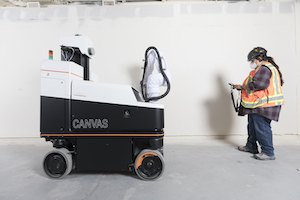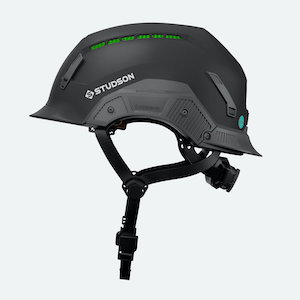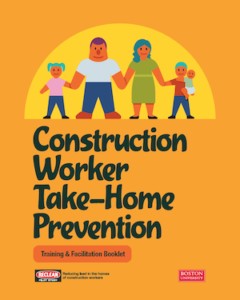The finalists for the 2022 Liberty Mutual Safety Innovation Award in Construction were announced at CPWR’s annual Research to Practice Seminar and Workshop in June. The award — sponsored by Liberty Mutual Insurance and administered by CPWR — recognizes innovative Evidence-Based technologies, work practices and programs (interventions) designed to reduce or eliminate construction hazards that lead to injuries and pain in the construction industry.
The winner receives a $15,000 cash prize and a plaque; two honorable mentions also receive a plaque.
Applications for the 2023 Liberty Mutual Safety Innovation Awards in Construction will open later this year. For background, read about the 2022 award process, including judging criteria and eligibility.
Grand Prize Winner
 Canvas Robotic Drywall Finishing Tool
Canvas Robotic Drywall Finishing Tool
DPR Construction
Drywall finishing can create significant risks: slippery floors, working at height, airborne fine particulates and strenuous repetitive motions. Typically, all seams are covered from floor to ceiling, which can lead to work on mobile scissor lifts, ladders or rolling scaffolds — all of which have fall risks. DPR Construction’s collaborative partnership with Canvas allows them to pilot Canvas’s robotic machine — featuring a sprayer system, lift station, mechanical arm and vacuum sanding system — that mitigates the riskiest aspects of drywall work. With the Canvas machine, which can telescope to 17 feet high, DPR protects workers from falls by letting the tool do the “high work.” Additionally, the Canvas arm, when outfitted with a sanding head and vacuum system, eliminates the repetitive sanding motion normally placed on workers and 99.9% of the dust generated by traditional finishing methods. Finally, Canvas eliminates multiple passes of finishing, instead completing work with a single sprayed coat of mud and a single sanding pass, while maintaining high-quality finishing. With Canvas, workers mix skilled manual work and operating robots. DPR’s partnership with Canvas is transforming drywall finishing, extending the careers of skilled craftsmen, creating new and exciting jobs for finishers of any background and placing the robot in harm’s way.
Honorable Mentions
 SHK-1 Industrial Safety Helmet
SHK-1 Industrial Safety Helmet
Studson
The hard hat is archaic technology. Its harness system design wasn’t intended to protect workers from impacts, just falling objects, and its design creates an even bigger risk: will it stay on during and after a fall? To respond, Studson brought shock-absorbing technology from action sports into an industrial safety helmet – the SHK-1 Industrial Safety Helmet. Its interior is similar to a bike helmet, providing better impact-energy absorption with Koroyd. Koroyd is a tubular or honeycomb structure that crumples in a more uniform manner, at angled impacts, and it performs better than expanded polystyrene or expanded polypropylene. The result is better brain protection in falls or strikes from objects. Studson also integrated into the design Brainshield by Shield-X — a silicone pad system which helps to reduce rotational forces during angled or oblique impacts. Finally, an embedded near-field communication chip in the helmet, from the Swedish company twICEme, allows the user to store an emergency medical profile with emergency contacts, allergies or other pertinent medical information (such as diabetes) that could mean the difference between life and death. Several additional features make the helmet more comfortable, breathable and adjustable, while retaining traditional aspects from the hard hat in the industrial design.
 RECLEAN Pilot Study: Reducing Lead in Construction Workers Homes
RECLEAN Pilot Study: Reducing Lead in Construction Workers Homes
Diana Ceballos, Boston University School Public of Health
Construction workers can inadvertently bring home potentially toxic metals such as lead from the jobsite, creating what are commonly known as “take-home” exposures. Take-home exposures often overlap with existing structural vulnerabilities, such as lead-based paints, in the neighborhoods and homes of these workers. Given the low-socioeconomic status of many construction workers, as well as their general lack of power to negotiate stronger occupational controls with employers, leaving the responsibility for minimizing take-home lead contamination with the workers is not sufficient to protect the health of families. This project aims to reduce lead exposures in the homes of construction workers through environmental and educational interventions that will empower workers and their families to prevent lead poisoning. Participants in the study are assigned to one of three groups carrying out different combinations of interventions, including having home inspections, using cleaning products designed for lead, completing an in-home education workshop or training on the best ways to reduce exposure to lead on the jobsite. Preliminary findings suggest these trainings are increasing the learning of workers and their families and providing useful new information and resources to reduce exposures.


 Join our thriving community of 70,000+ superintendents and trade professionals on LinkedIn!
Join our thriving community of 70,000+ superintendents and trade professionals on LinkedIn! Search our job board for your next opportunity, or post an opening within your company.
Search our job board for your next opportunity, or post an opening within your company. Subscribe to our monthly
Construction Superintendent eNewsletter and stay current.
Subscribe to our monthly
Construction Superintendent eNewsletter and stay current.